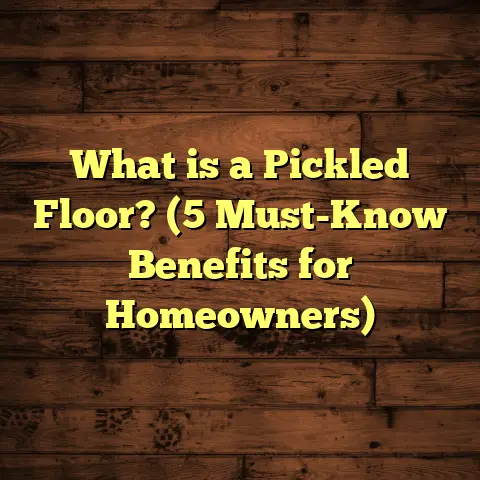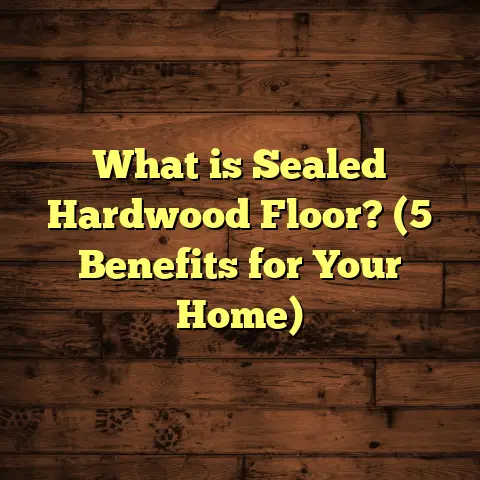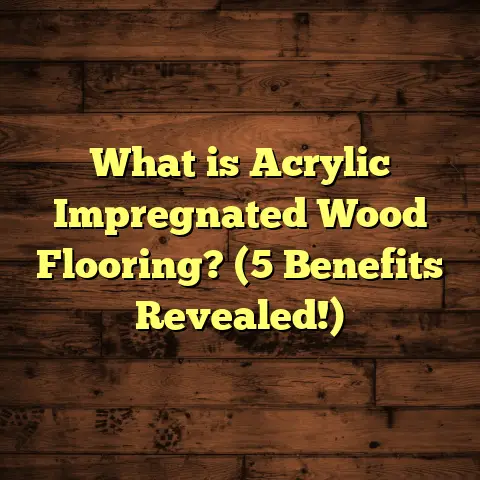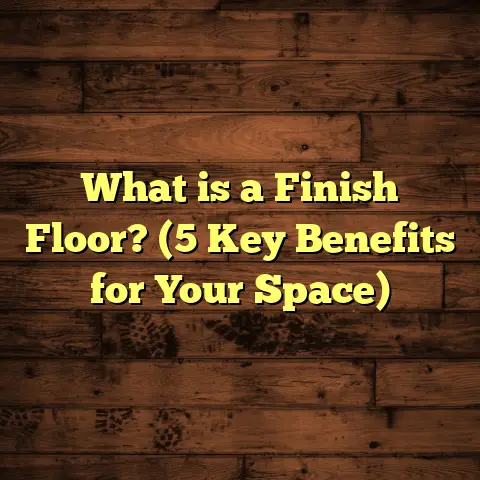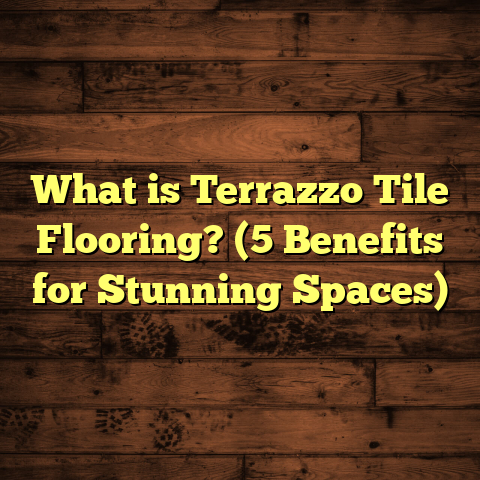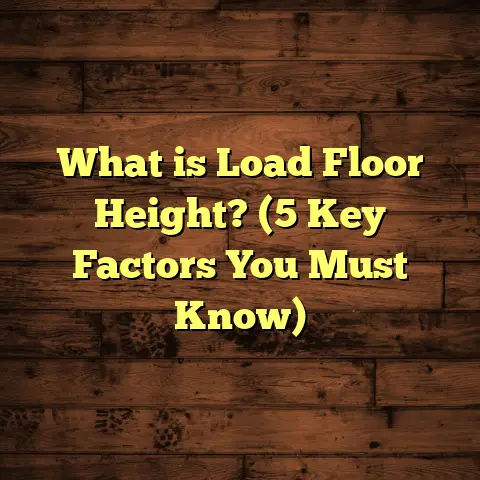What is Better: Vinyl or Bamboo Flooring? (5 Key Differences Revealed)
I still vividly recall the weekend I faced a tough decision for my home’s flooring. The old hardwood in my living room was tired and scratched up—years of life had left its mark. I wanted a change, but nothing too drastic or costly. My options boiled down to two popular choices: vinyl or bamboo flooring. Both had strong advocates, glowing reviews, and a range of styles that caught my eye. But which one would truly meet my needs—durability, aesthetics, budget, and long-term satisfaction?
That experience sparked a journey. I dove into research, consulted with suppliers and installers, and tested samples at home. Over several months and different projects, I gained firsthand insights that I want to share with you here. By the end of this article, you’ll be armed with the knowledge to pick the right floor for your space—without regrets.
What is Vinyl Flooring and Bamboo Flooring?
Let’s start with the basics—what exactly are vinyl and bamboo flooring?
Vinyl Flooring Explained
Vinyl flooring is a synthetic product primarily made from polyvinyl chloride (PVC), combined with plasticizers, stabilizers, fillers, and pigments. It originated as a budget-friendly alternative to natural materials but has evolved tremendously over recent decades.
Today’s vinyl floors come in several forms:
- Sheet vinyl: Comes in large rolls that can be cut to fit rooms seamlessly.
- Vinyl tiles: Square or rectangular tiles that are glued or clicked down.
- Luxury vinyl planks (LVP): Designed to mimic hardwood planks closely, with textured surfaces and realistic patterns.
Vinyl is known for its water resistance—many types are fully waterproof—and its ability to be installed over various subfloors including concrete, plywood, and even existing floors. Thickness varies, but LVP typically ranges from 4mm to 8mm thick, with wear layers between 6 mils (0.15mm) and 30 mils (0.75mm). The wear layer protects against scratches, scuffs, and stains.
In terms of cost, vinyl is generally affordable:
- Material costs: $2 to $5 per sq ft depending on quality and style.
- Installation: $2 to $5 per sq ft when professional help is used.
- Total: Around $4 to $10 per sq ft installed.
Vinyl’s popularity surged in regions like the US Midwest and Northeast due to its water resistance—ideal for basements and kitchens prone to moisture.
Bamboo Flooring Explained
Bamboo flooring is crafted from the bamboo plant—a grass species renowned for its rapid growth. Unlike hardwood trees that can take decades to mature, bamboo can be harvested every 3-5 years, making it a renewable resource.
The manufacturing process converts bamboo stalks into planks by slicing them into strips, boiling them to remove sugars (to prevent pest infestation), drying them, and then laminating or compressing them under heat and pressure.
There are three main types of bamboo flooring:
- Horizontal: Wide strips laid horizontally showing the grain.
- Vertical: Narrow strips laminated vertically for a linear look.
- Strand-woven: Bamboo fibers shredded and compressed under intense pressure for extreme hardness.
Strand-woven bamboo is the toughest type with a Janka hardness rating around 3,000—significantly harder than oak (~1,200). This makes it suitable for high-traffic areas.
Costs vary widely depending on grade and source:
- Material costs: $3 to $7 per sq ft for standard bamboo; premium strand-woven can be $7+.
- Installation: $4 to $8 per sq ft professionally installed.
- Total: $7 to $15 per sq ft installed.
Bamboo’s natural beauty and eco-friendly appeal have won over homeowners in urban areas like San Francisco and Seattle where sustainability is a priority.
1. Durability and Wear Resistance: Which Holds Up Longer?
Durability is a dealbreaker for many homeowners. I’ve seen floors that look great on day one but quickly degrade under everyday life—kids running around, pets scratching, furniture dragging.
Bamboo Durability
I installed strand-woven bamboo in my dining room three years ago. The floor still feels solid underfoot but has some minor dents where heavy chairs landed sharply. Bamboo’s hardness makes it resistant to scratches but not impervious.
Here’s what you should know about bamboo durability:
- Janka hardness rating: Strand-woven bamboo ~3,000; horizontal or vertical types 1,100–1,400.
- Moisture sensitivity: Bamboo can swell or warp if exposed to excess moisture over time.
- Scratch resistance: Good for normal household use but can show marks from sharp objects.
- Lifespan: Properly maintained bamboo can last 20+ years.
In one of my client’s homes in Denver, strand-woven bamboo installed in a living room held up well despite two dogs regularly running around. However, in a humid Florida condo I worked on recently, bamboo showed some buckling after prolonged moisture exposure—even with vapor barriers installed.
Vinyl Durability
For vinyl flooring, durability depends largely on the wear layer thickness:
- A wear layer of 12 mils (0.3 mm) is considered residential-grade.
- Commercial-grade vinyl has wear layers of 20+ mils.
I installed luxury vinyl plank flooring in a rental property kitchen last year. After 12 months of heavy use—including spills and pet claws—the floor looks nearly new thanks to its thick wear layer.
Vinyl is also waterproof and doesn’t swell like wood or bamboo. This makes it perfect for bathrooms or basements.
Side-by-Side Comparison
| Feature | Bamboo Flooring | Vinyl Flooring |
|---|---|---|
| Hardness (Janka) | Up to 3,000 (strand-woven) | N/A (synthetic; wear layer based) |
| Scratch Resistance | Moderate; can dent or scratch | High; scratches rare with thick wear layer |
| Water Resistance | Moderate; sensitive to moisture | Excellent; fully waterproof |
| Lifespan | 20+ years with care | 10-20 years depending on quality |
| Maintenance | Requires refinishing possible | Easy cleaning; no refinishing needed |
If you want something ultra-durable for kids or pets without fussing over moisture issues, vinyl often performs better. But if you prefer natural material with high hardness (strand-woven), bamboo is still a strong contender.
2. Installation Process: How Long Will It Take?
Installation can be a major factor in deciding flooring types because it affects total project time and costs. Here’s what I learned installing both materials myself and supervising crews.
Vinyl Installation
Vinyl flooring scores big points for ease and speed. I installed 350 sq ft of luxury vinyl plank in just under two days with no prior professional experience.
Key points include:
- Subfloor prep: Vinyl can be installed over concrete, plywood, or existing floors if flat.
- Acclimation: Minimal or none required; vinyl doesn’t expand much.
- Tools: Utility knife, tapping block, measuring tape.
- Installation methods: Click-lock planks snap together; glue-down vinyl requires adhesive application.
- Timeframe: A typical 300 sq ft room can be done in 1-3 days by DIYers or pros.
A homeowner I know replaced carpet with vinyl flooring in her basement over a weekend—she was thrilled with how quickly the space transformed.
Bamboo Installation
Bamboo installation requires more attention:
- Acclimation: Planks need at least 72 hours in the room before installation to adjust to humidity.
- Subfloor prep: Must be clean, dry, level; plywood preferred over concrete.
- Underlayment: Necessary for soundproofing and moisture barrier.
- Installation methods: Nail-down or glue-down; floating installations less common.
- Timeframe: Professional installation takes about 3-5 days for an average room (300–400 sq ft).
I once supervised a crew installing bamboo flooring in a client’s condo in Boston. The acclimation period delayed work by three days but prevented future warping issues.
Cost Impact of Installation Time
Longer installation means higher labor costs.
| Flooring Type | Average Installation Time | Labor Cost Per Sq Ft (Chicago) | Typical Installation Cost Range |
|---|---|---|---|
| Vinyl | 1–3 days | $2 – $5 | $600 – $1500 for 300 sq ft |
| Bamboo | 3–5 days | $4 – $8 | $1200 – $2400 for 300 sq ft |
If you’re on a tight schedule or want to DIY without special tools or skills, vinyl is more forgiving.
3. Cost Breakdown: Which Fits Your Budget?
Budget plays a huge role when selecting flooring. I’ve seen people overspend chasing looks without accounting for installation or maintenance costs—which leads to frustration later.
Material Costs
Vinyl generally comes out less expensive upfront:
- Basic sheet vinyl: $1 – $3 per sq ft.
- Mid-range luxury vinyl plank: $2 – $5 per sq ft.
- High-end LVP: up to $7 per sq ft.
For bamboo:
- Horizontal/vertical bamboo: $3 – $5 per sq ft.
- Strand-woven premium: $6 – $9+ per sq ft.
I priced out materials recently at three suppliers in New York City:
- Vinyl LVP sample pack averaged $3.50/sq ft.
- Strand-woven bamboo ranged from $7 to $11/sq ft depending on grade.
Installation Costs
Vinyl requires less specialized labor unless glue-down method is used:
- DIY installation possible for click-lock planks.
- Professional rates: $2 – $5/sq ft.
Bamboo often requires professionals due to acclimation and nailing/gluing:
- Labor rates higher at $4 – $8/sq ft.
Maintenance Costs Over Time
Vinyl flooring needs minimal maintenance—regular sweeping and occasional mopping. No refinishing required.
Bamboo may need refinishing every 7–10 years depending on wear—a cost of roughly $1–$3 per sq ft for sanding and sealing.
Total Cost Over 15 Years (Estimate)
| Flooring Type | Initial + Installation Cost (300 sq ft) | Refinishing & Maintenance Cost (15 years) | Total Estimate |
|---|---|---|---|
| Vinyl | $1,800 – $3,000 | Minimal | ~$2,000 – $3,200 |
| Bamboo | $2,400 – $4,500 | $600 – $900 | ~$3,000 – $5,400 |
If upfront cost is your biggest concern, vinyl wins hands down. But if you value longevity and don’t mind investing in upkeep every decade or so, bamboo may be worth the premium.
4. Environmental Impact: Which Is Greener?
I personally care about sustainability in home projects—it feels good knowing your choices support the planet.
Bamboo’s Green Credentials
Bamboo grows incredibly fast—up to three feet per day—and matures in about five years compared to decades for hardwood trees. This rapid renewability reduces deforestation risks when harvested responsibly.
Other environmental benefits:
- Bamboo absorbs more CO2 than many tree species during growth.
- Natural material that biodegrades at end of life.
- Some manufacturers use low-VOC finishes reducing indoor air pollution.
But watch out: Not all bamboo is equal. Some production involves chemical treatments or imports from regions with lax environmental standards.
Vinyl’s Environmental Footprint
Vinyl is petroleum-based plastic with environmental challenges:
- Production releases greenhouse gases.
- Difficult to recycle widely; most end up in landfills.
- Recent advances include recycled content incorporation and lower emission manufacturing processes by some brands.
According to research by the Environmental Building News (2023):
- Bamboo flooring has approximately 30% lower embodied energy than comparable hardwoods.
- Vinyl’s embodied energy is roughly double that of bamboo per square foot installed.
If eco-friendliness tops your list, bamboo generally has the edge—provided you choose certified sustainable options like FSC-certified products or those verified by independent organizations such as the Forest Stewardship Council.
5. Style and Design Options: What Fits Your Vision?
When I renovated my living room, style was everything—I wanted warmth but modern flair without overwhelming patterns.
Vinyl Design Variety
Vinyl’s synthetic nature lets manufacturers replicate almost any surface:
- Wood-look planks with realistic grains and knots.
- Stone-look tiles mimicking marble or slate.
- Bold patterns like geometric shapes or colorful motifs.
- Matte or glossy finishes available depending on preference.
Colors go from traditional browns to grays or even blues—perfect if you want trendy looks without natural material constraints.
Bamboo Aesthetic Appeal
Bamboo offers natural textures that vary by manufacturing style:
- Horizontal grain gives wider plank look with visible nodes.
- Vertical grain provides a linear striped appearance.
- Strand-woven has rich texture resembling exotic hardwoods with intricate patterns.
Colors range from pale blondes to rich ambers or even carbonized dark browns created by heat treatment during manufacturing.
Bamboo ages gracefully—developing a warm patina over time unlike synthetic surfaces that tend to stay unchanged or fade unevenly if exposed to UV rays.
Personal Stories & Case Studies From My Work
Case Study #1: Family Home in Portland
A family of four wanted durable yet eco-conscious floors for their open-concept living/dining area (~450 sq ft). After sample testing:
- Chose strand-woven bamboo for its toughness and natural vibe.
- Installed professionally over five days including acclimation.
- Cost: Approx. $11 per sq ft installed ($4950 total).
Two years later they report minimal scratches despite kids playing hard indoors—and love the natural warmth it adds.
Case Study #2: Urban Apartment Basement Remodel in Chicago
A renter needed waterproof floors for a damp basement apartment (~300 sq ft).
- Selected luxury vinyl plank with 20 mil wear layer.
- DIY installation completed over a weekend.
- Total cost under $1800 including materials.
After 18 months of heavy use including pets and occasional spills—still looks brand new with zero water damage.
Maintenance Tips Based on My Experience
Whether you go vinyl or bamboo—maintenance keeps floors looking their best longer:
Vinyl Care
- Sweep regularly to remove grit that causes abrasion.
- Mop with mild detergent; avoid harsh chemicals that degrade wear layers.
- Protect corners from sharp furniture legs using pads.
Bamboo Care
- Clean spills immediately to prevent water damage.
- Use soft broom or vacuum attachments designed for hardwood floors.
- Avoid waxing; refinish every 7–10 years if scratches appear.
Final Thoughts: What Worked Best For Me?
After years of installing both materials in varied settings—from cozy homes to commercial spaces—I’ve learned that no single answer fits everyone perfectly.
If you want quick installation, waterproof performance, budget-friendly pricing—and don’t mind synthetic materials—vinyl is an excellent choice that delivers consistent results. It’s especially ideal for bathrooms, basements, rentals, or high-moisture areas where natural wood products struggle.
But if warmth, sustainability, natural beauty—and willingness to invest slightly more time and money matter—you can’t beat bamboo’s charm. Strand-woven bamboo combines toughness with eco-friendliness like few other options available today.
Personally? For my primary living spaces where I want natural ambiance and durability combined—I picked strand-woven bamboo after thorough testing. For utility rooms and rentals where water resistance rules—I rely on luxury vinyl plank flooring every time.
If you’re thinking about your home floors now—what questions do you have? Anything specific about installation challenges? Or maybe curious about maintenance tricks? I’m happy to share more stories from my projects or help crunch numbers based on your room size!
Remember—your floor shapes your living experience every day. Choose what feels right under your feet as much as what looks good on paper!
